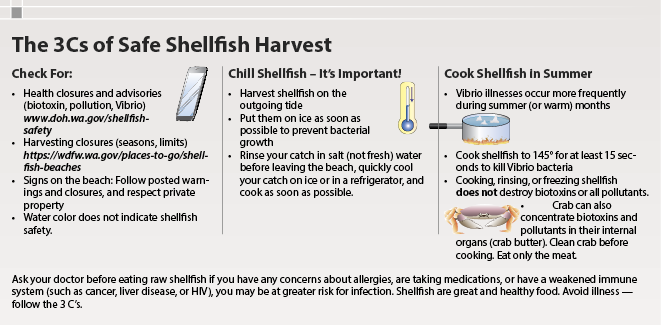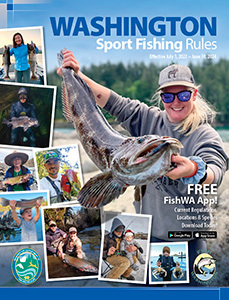Shellfish Safety Information
Eating contaminated shellfish or seaweed can cause serious illness or death. The only way to be safe is to "Know Before You Dig". Always check for current beach closures and advisories related to biotoxins, pollution, or other human health concerns the same day you plan to harvest:
Always check both the current wdfw season and the doh health closure status before harvesting any public beach.
Biotoxin Closures
Don't harvest in areas with marine biotoxins, also known as "Red Tide". You could get sick or die.
Paralytic Shellfish Poisoning (PSP) & Amnesic Shellfish Poisoning (ASP) & Diarrhetic Shellfish Poisoning (DSP):
- Can make you sick or cause death
- Can't be destroyed by cooking or freezing
- Are produced by algae and do not always turn the water red
- Can remain in butter and varnish clams longer than in other shellfish species
Pollution Closures
Don't harvest in areas that are polluted. You could get sick.
Pollution can come from many sources like sewage drain pipes, failing septic systems, farm practices, boats, and pet waste. Some closures and advisories are listed below. Visit
Vibrio Warnings
Be aware of Vibrio Warnings. You could get sick.
Vibrio Bacteria:
- Cook all shellfish thoroughly to kill bacteria and to avoid getting sick
- Highest risk from May-September, especially in Puget Sound and Hood Canal
- Are naturally occurring bacteria that can multiply rapidly in warm conditions
Help Keep Our Waters Safe and Clean
Human and pet waste can make people sick and cause harvest closures. Please do your part to protect our waterways and shellfish beaches:
- Use public toilets. Scoop, bag and trash human waste if no facilities are available.
- Scoop, bag, and trash your pet's waste.
- Pump, don't dump! Use pumpout stations to dispose of boat sewage. Visit
https://pumpoutwashington.org .

Never Relocate Shells or Shellfish Without a Permit From WDFW!
Like humans and other animals, shellfish can get sick. It is illegal to move shells and shellfish from beach to beach or between state waters without a transfer permit. When you move animals and shells from one area to another, you can accidentally introduce or spread harmful pests and diseases. These movements include activities like:
- Transferring shellfish to seed your beach
- Putting used oyster shells on beaches
- Storing shellfish harvested from other areas or bought from the store on a beach or off a dock
- Releasing any aquatic animals into state waters for any reason.
Help safeguard Washington shellfish. For additional information, visit
https://invasivespecies.wa.gov/priorityspecies/infectious-shellfish-diseases/. To apply for a transfer permit visit https://wdfw.wa.gov/licenses/fishing/shellfish-import-transfer.
Year-Round Closures — Clams, Oysters, and Mussels |
Closures may be subject to change. Always check current WDFW season and DOH water quality status the same day you plan to harvest at |
Beach Name |
County |
Alki Park |
King |
Alki Point |
King |
Bay Center Oyster Reserve (Willapa Harbor reserves) |
Pacific |
Bay View State Park |
Skagit |
Blaine Marine Park (formerly Semiahmoo) |
Whatcom |
Blake Island State Park Marina |
Kitsap |
Blowers Bluff North |
Island |
Brown's Point Lighthouse |
Pierce |
Budd Inlet, south of Burfoot County Park |
Thurston |
Cama Beach State Park |
Island |
Camano Island State Park |
Island |
Chuckanut Bay |
Whatcom |
Coupeville |
Island |
Cultus Bay |
Island |
Dash Point County Park |
King |
Dave Mackie County Park |
Island |
Deception Pass State Park, Rosario Beach tidepools only. |
Island |
Des Moines City Park |
King |
Discovery Park |
King |
DNR-142 |
Island |
DNR-144 (Sleeper) |
Island |
Dockton County Park |
King |
Dosewallips State Park South (defined by posts on the beach) |
Jefferson |
East San de Fuca |
Island |
Eld Inlet Oyster Reserve (Mud Bay reserves) |
Thurston |
Evergreen Rotary Park (Port Washington Narrows) |
Kitsap |
Fay Bainbridge Park |
Kitsap |
Fudge Point State Park |
Mason |
Gertrude Island |
Pierce |
Golden Gardens |
King |
Graveyard Spit (Dungeness Bay) |
Clallam |
Guillemot Cove Nature Preserve |
Kitsap |
Guss Island (formerly Garrison Bay) |
San Juan |
Howarth Park/Darlington Beach |
Snohomish |
Joemma Beach State Park |
Mason |
Kayak Point County Park |
Snohomish |
Kitsap Memorial State Park |
Kitsap |
Lent Landing (Port Washington Narrows) |
Kitsap |
Lincoln Park |
King |
Lions Park (Bremerton) |
Kitsap |
Lofall |
Kitsap |
Long Island Slough Oyster Reserve (Willapa Harbor reserves) |
Pacific |
Long Point West |
Island |
Lower Roto Vista Park |
Kitsap |
March Point Recreation Area |
Skagit |
McNeil Island |
Pierce |
Meadowdale County Park |
Snohomish |
Mee-Kwa-Mooks Park |
King |
Monroe Landing |
Island |
Mukilteo |
Snohomish |
Nahcotta Tidelands (closed for clams year-round, oysters open year-round) |
Pacific |
Nemah Oyster Reserves (Willapa Harbor reserves) |
Pacific |
Nisqually National Wildlife Refuge |
Thurston |
North Beach County Park |
Jefferson |
Oak Bay County Park |
Jefferson |
Oak Harbor |
Island |
Oak Harbor Beach Park |
Island |
Oak Harbor City Park |
Island |
Oak Harbor (north of WINAS-Maylor) |
Island |
Old Mill County Park (Silverdale) |
Kitsap |
Olympia Shoal |
Thurston |
Pat Carey Vista Park |
Kitsap |
Picnic Point County Park |
Snohomish |
Pitship Point |
Clallam |
Pitt Island |
Pierce |
Pleasant Harbor State Park |
Jefferson |
Pleasant Harbor WDFW Boat Launch |
Jefferson |
Point Defiance |
Pierce |
Port Angeles Harbor |
Clallam |
Port Gardner |
Snohomish |
Post Point |
Whatcom |
Priest Point County Park |
Thurston |
Rat Island (south of Fort Flagler State Park) |
Jefferson |
Retsil |
Kitsap |
Richmond Beach Saltwater Park |
King |
Salt Creek Recreation Area (DNR-419) |
Clallam |
Saltair Beach (Kingston Ferry Terminal) |
Kitsap |
Saltwater State Park |
King |
Samish Bay (southwest portion) |
Skagit |
Scenic Beach State Park |
Kitsap |
Seahurst County Park |
King |
Semiahmoo County Park |
Whatcom |
Semiahmoo Marina |
Whatcom |
Silverdale Waterfront Park |
Kitsap |
Sinclair Inlet |
Kitsap |
Skagit Wildlife Area |
Skagit |
South Carkeek Park |
King |
Southworth |
King |
Stuart Island State Park - Reid Harbor (South Beach) |
San Juan |
Taylor Bay |
Pierce |
Totten Inlet Oyster Reserve (Oyster Bay reserves) |
Thurston |
Walker County Park |
Mason |
West Pass Access |
Snohomish |
Willapa River Oyster Reserve (Willapa Harbor reserves) |
Pacific |
Woodard Bay Natural Resource Conservation Area |
Thurston |
Harvest Advisories — Clams, Oysters, and Mussels |
|
The Department of Health (DOH) has harvest advisories or closures on the following beaches. An advisory is placed on a beach that MAY be subject to periodic contamination from pollution sources or MAY intersect polluted areas. Before harvesting shellfish check the Department of Health's website www.doh.wa.gov/shellfishsafety, call (360) 236-3330, or contact the local county health department. For beach-specific information and other harvest rules and information, check the WDFW website at |
|
Beach Name |
County |
Anna Smith Children's Park |
Kitsap |
Blake Island (avoid marina and mooring buoys) |
Kitsap |
Bottle Beach |
Grays Harbor |
Brownsville |
Kitsap |
Chimacum Creek Tidelands (Irondale Beach Park) |
Jefferson |
Copalis Beach (Oyhut Beach Approach) |
Grays Harbor |
Duckabush |
Jefferson |
East San de Fuca Boat Ramp |
Island |
Freeland County Park |
Island |
Inspiration Point Natural Area |
King |
Jarrell Cove |
Mason |
Larrabee State Park (north end) |
Whatcom |
Liberty Bay |
Kitsap |
Madrona (Penn Cove) |
Island |
Maple Grove County Park |
Island |
Mystery Bay State Park |
Jefferson |
Port Gamble Heritage Park (consumption advisory) |
Kitsap |
San de Fuca |
Island |
Seabold |
Kitsap |
Silverdale Shoal - Clam Island |
Kitsap |
Twanoh State Park |
Mason |
West Dougall Point |
Mason |
West Penn/Twin Lagoons |
Island |
WINAS-Maylor Pt East (inside Crescent Harbor) |
Island |
WINAS-Maylor Pt West (inside Oak Harbor) |
Island |

